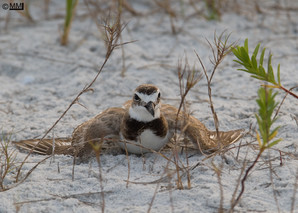Events:
July 11: Shorebird Walk at Matanzas Inlet
July 23: Breakfast with the Birds at Rookery Bay
Reminders:
July 8-14: The July count window for the Breeding Bird Protocol. Whenever possible, weekly surveys are preferred for routes with active nesting; it helps capture information about peak counts.
Fourth of July and All Summer: Beach stewards are needed at important beach nesting sites. Check out the map of local stewardship opportunities and contact us to get involved!

Partner Spotlight: Jason DePue of the St. Johns/Flagler Shorebird Partnership
Jason DePue has served as the District 3 Biologist of the Florida park Service for over 14 years. In this role, he works tirelessly to protect and manage 33 parks through habitat restoration projects, prescribed fire, exotic plant control, and listed species management.
Jason has been a key member of the St. Johns/Flagler Shorebird Partnership since its inception in 2006. He also oversees the management and monitoring of shorebirds and seabirds at Anastasia State Park. Prior to the start of each breeding season, Jason coordinates vegetation management and pre-posting events to secure over 6 acres of nesting grounds. During the season, he works diligently to monitor the 4 mile stretch of beach with long-time park volunteer, Sue Killeen.
Throughout the breeding season Jason works with FWC and FSA partners to expand posted areas and ensure new vulnerable nesting sites are protected. At a time when imperiled beach-nesting birds are struggling to survive on Florida’s Atlantic Coast, this park remains a beacon of hope. In recent years, Anastasia State Park has been home to the largest and most successful least tern colonies on the Atlantic Coast of Florida. In addition, black skimmers returned to nest at the park starting in 2017. This was the first time in at least two decades where successful nesting was documented in St. Johns County.
Jason’s interest in shorebirds was first sparked through an internship with the Environmental Lands Division in Pinellas County. Over time, while working with a wide variety of agencies and organizations, he learned the importance of active management in preserving biodiversity on Florida’s remaining wild lands. When asked, Jason will say his favorite part of the job is the opportunity to work with fellow volunteers and land managers to conserve wildlife and wildlife habitat.
For anyone who has had the opportunity to work with Jason, his dedication to conservation and conservation partnerships becomes immediately clear. Despite his enormous area of responsibility, Jason always finds time to share his knowledge and passion for shorebird conservation with FSA partners, volunteers, and park visitors. A big thank you to Jason for his ongoing commitment to protecting imperiled beach-nesting birds in Northeast Florida!
|

Be a 4th of July Beach Hero!
As people make plans to go to the beach for the Independence Day holiday, the FWC is reminding the public to help protect beach-nesting shorebirds by giving them space and keeping personal fireworks off the beach.
Shorebirds on Florida’s Atlantic and Gulf coasts are nesting now, with many of them watching over flightless chicks. Threatened species such as the snowy plover, least tern, black skimmer and American oystercatcher are among the shorebirds facing conservation challenges and needing help from people to survive. Loud noises can cause adults to flush off their nests and tiny chicks to become separated from parents, leaving them vulnerable to predators, the elements, and getting stepped on by beachgoers.
Be a 4th of July Beach Hero:
- Leave personal fireworks at home and attend an official display instead. The loud sounds and bright lights of impromptu fireworks on Florida's beaches and waterways can have catastrophic effects on nesting birds and their chicks, as well as nesting sea turtles.
- Stay out of posted areas, including Critical Wildlife Areas, and keep your distance from nesting shorebirds and sea turtles.
- Leave Fido at home. But if you walk your dog on a pet-friendly beach, keep it on a leash and at a distance from birds, sea turtles, and their nests.
- Do not feed birds or leave trash, picnic leftovers or fish scraps on the beach. These scraps attract predators that will eat the eggs and hatchlings of birds and sea turtles.
- Boaters also can help protect nesting birds by not getting close to or making loud noises near Critical Wildlife Areas.
Have a safe and happy 4th of July and remember to share the shore!
Photo: Jean Hall
|

That's Impressive!
In 2018, 273 FSA partners entered more than 10,000 records into the Florida Shorebird Database and surveyed 894 miles of Florida’s shorebird and seabird habitats. That is approximately the distance from Tallahassee to Washington, D.C.!
Want to know more about what FSA partners did in 2018? Stay tuned for the release of the Florida Shorebird Alliance Monitoring Report coming very soon!

Broken wing or Just Bluffing?
In an attempt to persuade predators away from nests, some breeding shorebirds (including the photographed Wilson's plover) will perform a "broken wing display". If you ever see shorebirds doing this, it is time to back away because you're far too close to their nest!
Learn more about broken wing display in this short video and facebook post. If you see someone intentionally disturbing a bird, call our hotline:1-888-404-FWCC (3922).
Photo: Mia McPherson
|
|